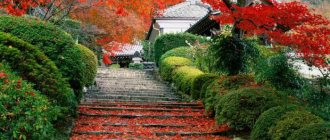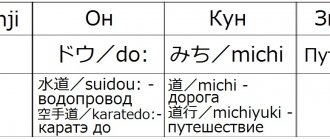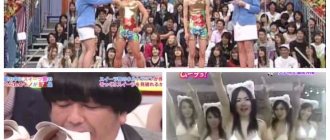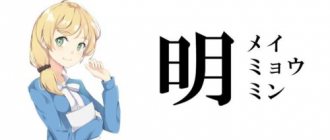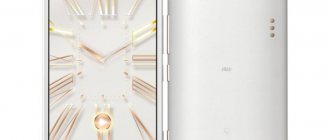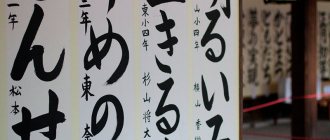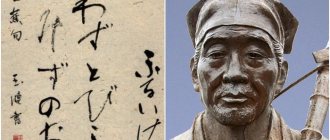Japan is somewhat reminiscent of a lone person who believes that the world is not yet ready to accept him. For a long time the country hid from the rest of the world and only at the beginning of the twentieth century began to establish friendly relations with other states. From this moment on, interest in everything Japanese increases significantly. Cuisine, traditions, holidays, mentality, clothing - all this interests the public. Many Europeans are trying to understand the basics of the Japanese language. The first thing problems arise with are numerals, namely Japanese numbers.
Features of Japanese numerals
Japanese numerals are a special combination of numbers that consists of Chinese and Japanese counting systems. Due to the fact that the Chinese system is duplicated, Japanese hieroglyph numbers have a double reading: OH (on) and KUN (kun).
Usually in Japan they use Arabic numbers, but you can also find hieroglyphs. They are especially often found on the menu of restaurants at ryokans (traditional Japanese hotels). In addition, hieroglyphs are used if you need to write text “vertically”. Arabic numbers are used for horizontal writing.
Residents of the Land of the Rising Sun have two counting systems: their own (counting only up to 10) and borrowed (Chinese). The rules of use are quite simple: Chinese numbers are always used with suffixes, Japanese numbers can exist independently.
Basic counting words in Japanese
Although you will be able to communicate by knowing only the universal counting words, knowing how to use other such words is an important part of learning Japanese. Unless you're a beginner, you've probably already learned some of these without even realizing it.
-ko (個, こ)
After the universal counting words, 個 is probably the next most useful counting word in Japanese. It is typically used to count small items such as fruit.
I ate one tangerine
みかんを一個食べました。
Mikan o i-ko tabemashita
.
Note:
in most cases, you shorten "iti" to "i" when it comes before a counting word, so you pronounce "ee-kko" rather than "iti-ko."
For example, clouds, empty containers, typhoons, planets and bacteria are also counted using 個.
-nin (人, にん)
It is a counting word used when counting people, except when there are only one or two people. For one person you say hitori (hitori)
(一人, ひとり), and for two -
futari
(二人, ふたり).
For other numbers, you simply say the number plus the counting word, like this:
Three persons
三人 (さんにん)
Sannin
Four people
四人 (よにん)
Yonin
Note that normally 四 is pronounced "yong", but here you don't pronounce the "n" sound. You also never say "xinin".
-hiki (匹, ひき)
It is a counting word that you use to count small to medium sized animals such as cats, dogs, fish, insects, as well as monsters and imaginary creatures. For larger animals, use the counting word tou
(頭, とう).
I have one cat, two dogs and three rabbits
Neko o ippiki, inu o ni-hiki to usagi san-biki katte imasu
. Note the changes in pronunciation when "hiki" becomes "pikey" or "biki" depending on the numeral before it. Other numerals after which the pronunciation changes:
6
=
roppiki
, 8
=
happiki
,
10
=
jūppiki, 100 = hyappiki
,
1000
=
sen
(
senbiki )
,
せんびき
10,000
=
itimanbiki (ichimanbiki)いちまんびき
This can be confusing for beginners, especially since there are other counting words whose pronunciation varies. But the more you practice, the more naturally you will be able to use counting words.
-en (円, えん)
This is a counting word for money, for example:
100 yen
100円 (百円), ひゃくえん
hyaku-en (Hyaku-en)
1000 yen
1000円 (千円), せんえん
sen-en (Sen-en)
10,000 yen
10,000円 (一万円), いちまんえん
ichiman-en (Ichiman-en)
-ji (時), -fun/-pun (分), -nen (年), etc.
These are counting words for units of time. Also this:
Second
=
-byō (byō)
秒, びょう
Minute
=
-fun/-pun (fun/pun)
分, ふん/ぷん
Hour
=
-ji (ji)
時, じ
Day
=
-nichi/ka (nichi/ka)
日,にち/か
Week
=
shūkan
週間, しゅうかん
Month
=
getsu
月, げつ
Year
=
nen
年, ねん
Note about 日:
you can use this word to count the actual number of days, and you can also use it to talk about calendar days. But you say "threads" when you count days, and "ka" for calendar days. For example:
2 days
二日 (ににち)
ni-nichi (Ni-nichi)
Second day of the month
二日 (ふつか)
futsuka
Note that when the number of days exceeds ten, you use “threads (nichi)”, for example:
15th day of the month
十五日 (じゅうごにち)
juugo-nichi (Jūgo-nichi)
You also need to remember that the first and twentieth of the month have their own pronunciation:
First day of the month
一日 (ついたち)
tsuitachi (Tsuitachi)
20th day of the month
二十日 (はつか)
Hatsuka
Also be careful with the reading for the 8th of the month - yo
ka
, ようか, even if the native Japanese reading for 8 is "yattsu".
Don't worry if this all seems too complicated and confusing to you. The longer you study Japanese, the easier it becomes to remember such nuances. Just take the time to practice!
-hon (本, ほん)
This is a counting word for long objects such as pens/pencils, bottles, chopsticks, train tracks, rivers and umbrellas.
Note that although the word 本 means “book” in Japanese, it is not the counting word you use to count books (more on this later).
You simply say the number of objects by adding "hon" to it, except when the numeral ends in 3, 1, 6, 8 or 10
. The number 3 is followed by "bon", and the numbers 1, 6, 8 and 10 are followed by "pon".
-satsu (冊, さつ)
This is a counting word for everything related to books: books, notebooks, magazines, booklets, dictionaries and so on.
I bought two Murakami novels yesterday.
Kino,
Murakami no shousetsu wo ni satsu kaimashita.
-mai (枚, まい)
Use this counting word when counting flat, thin objects such as pieces of paper and tickets. It can also be used to count clothes such as pants and shirts, as well as walls and soba portions.
For example:
(Buying tickets at the box office) 2 tickets please
二枚お願いします。
Ni mai onegaishimasu
-kai (回, かい)
This counting word is used to count the frequency of certain events. This will be translated into Russian as “one time”, for example:
I've been to Japan three times
日本に三回行ったことがあります。
Nihon ni san kai itta koto ga
arimasu
You can also use it to count spins/flips.
Note that 階, which is the counting word for floors of a building, is also read as kai
. Pay attention to the kanji and context to understand which word is being used.
-soku (足, そく)
The kanji for this counting word means "foot" or "leg", so we use it to count pairs of shoes, slippers, socks, skates, etc.
I have six pairs of socks
靴下が六足あります。
Kutsushita ga roku soku arimasu.
In the case of the number 3, the pronunciation changes to “zoku”, for example:
I have three pairs of shoes
靴が三足あります。
Kutsu ga san zoku arimasu.
In cases with 8 or 10 items, the pronunciation changes to "ha-ssoku" and "ju-ssoku", instead of "hachi soku" or "juu soku".
From 1 to 10
To become more familiar with Japanese numbers, you need to know how they are written and read. The table below shows Japanese numbers from 1 to 10 with different pronunciations:
| Number | Hieroglyph | HE (Chinese pronunciation) | KUN (Japanese pronunciation) |
| 1. | 一 | Ichi | Hitotsu |
| 2. | 二 | Neither | Futatsu |
| 3. | 三 | San | Mitsu |
| 4. | 四 | Shi | Yotsu |
| 5. | 五 | Go | Itsutsu |
| 6. | 六 | Roku | Mutsu |
| 7. | 七 | Shichi | Nanatsu |
| 8. | 八 | Hachi | Yatsu |
| 9. | 九 | Kuu | Kokonotsu |
| 10. | 十 | Ju | Too |
As can be seen from the presented material, numbers in Japan have a double name. Moreover, pronunciation may differ in different regions. For example, the number 8 can be pronounced either “hachi” or “hati” or “hasi”.
There are also two different names for the Chinese numbers 4, 7 and 9:
- 4 – “Yong”.
- 7 – “Nana”.
- 9 – “Kyu”.
Basic numbers and counting system
Basic numbers and the counting system in Japanese are quite simple. Take a look at our table with Japanese numbers from 1 to 10, both for native Japanese, or wago
和語, and Chinese-Japanese, or
kango
漢語.
| Number | Kanji | Onny reading (Chinese) | Kun reading (Japanese) |
| 1 | 一 | iti (Ichi) いち | Hitotsu |
| 2 | 二 | ni (Ni)に | Futatsu |
| 3 | 三 | san (San) | Mitsu |
| 4 | 四 | si (Shi) し、yon (よん) | Yotsu よつ |
| 5 | 五 | go (Go)ご | itsutsu |
| 6 | 六 | Roku ろく | Mutsu |
| 7 | 七 | city (Shichi) しち、Nana なな | Nanatsu ななつ |
| 8 | 八 | hachi (Hachi) | Yatsu (Yattsu) |
| 9 | 九 | ku (Ku) く、Kyū きゅう | Kokonotsu |
| 10 | 十 | juu (Jū) じゅう | tou (Tō)とう |
A few points to note:
- For numbers from 1 to 10, you use only native Japanese (kun) readings. They do not require any counting words, so are themselves universal counting words
that can be used to count most items except people, money and time. - Chinese number reading always requires counting words. Since it is also used to read numbers greater than 10, it is used more often.
Interesting to know
In Japan, the numbers 4 and 9 are considered unlucky. Four is pronounced "shi", which is similar to the Japanese word for "death". Therefore, very often the pronunciation of “shi” is changed to “yong”. Nine, in turn, is consonant with the word "suffering", which is pronounced simply as "ku". Therefore, you can often hear a modification of the pronunciation of the number 9.
In modern Japanese, all numbers except 4 and 7 have Chinese pronunciation (that is, they are read as “onna”). But in the names of the months, even they are pronounced with “OH”.
More than a hundred
Japanese numbers are formed by adding one numeral to another. Even hundreds are formed in this way. 100 (百) is pronounced "hyaku" in Japanese. To form the numerals 300, 400, etc., you must pronounce the name of the corresponding number from the first table before “hyaku”. Here are some examples:
- 300 (三百) – Sanhyaku.
- 400 (四百) – Yonhyaku.
- 500 (五百) – Gohyaku.
Almost no one has any difficulties with this question. The fun begins when you need to pronounce a three-digit number, which is not in the examples. For example, 125. In theory, it is clear that all the numerals that make up the number must be added together, but in practice many are lost. 125 would sound like "hyakuninjugo" in Japanese. If you write the number using kanji (hieroglyphs), then you get 百二十五. That is, 125 is the sum of the numbers: 100+20+5.
The numbers 1000 and 10000 are denoted as:
- 千 – Sen (thousand).
- 万 – Man (ten thousand).
The numbers are formed in exactly the same way as the previous groups of numbers. For example, 1367 Japanese numbers translated into Russian will sound like “sen (1000) sanhyaku (300) rokujunana (67).” In this way, you can easily form numbers until you need to say a million.
Perhaps this is an exception to the rule. If six-digit numbers are formed by combining numbers of previous orders (“juni” or “niju”), then a million is formed using the numbers 100 and 10,000. Accordingly, 1,000,000 will sound like “Hyakuman”.
Counting large numbers
Of course, you can count much larger numbers in Japanese. Here are some of our tips!
Counting to 100 is very easy if you understand how to form numbers - count tens by adding the desired number to them. For example: “11” is one 10 (juu) and 1 (ichi), that is, “juu-iti” “25” is two 10s (ni-juu) and 5 (go), that is, “ni- juu-go” “35” is three 10s (san-juu) and 5 (go), that is, “san-juu-go”, etc.
Continuing upward, you need to follow this pattern, except for numbers like 100 (百, hyaku hyaku
), 1000 (千, sen
sen
) and 10,000 (一万, ichiman
ichiman
), for which there are words.
For example, the number 5750 is made up of five 1000s, seven 100s and five 10s, resulting in "go-sen-nana-hyaku-go-juu".
It's important to note that for numbers from 10 to 1000, you don't say "ichi" if the number starts with 1. For example, 1500 is not "ichi-sen-go-hyaku", but simply "sen-go-hyaku". Likewise, 150 is pronounced "hyaku-go-juu" rather than "ichi-hyaku-go-juu".
For even larger numbers, such as 100,000 and 1,000,000, you need to look at how many “manas” they consist of. For example, if 10,000 is one “man” 万, then 100,000 is ten “man” 万 - “juu-man”.
One million is 100 "mana" 万, so in Japanese "million" becomes "hyaku-man".
Pay off the first or third!
Japanese numerals are very easy to remember. And if you learn the numbers from 1 to 12, then you don’t have to bother with memorizing the months of the year. In Japan they have no names. Simply add the word “gatsu” to the number that indicates the month number. For example, January will sound like “Ichigatsu,” which literally means “first month.” It is worth paying attention to the fourth and seventh months. When it comes to months, the “exceptional” ones—April and July—are pronounced “in Chinese,” that is, with “on” pronunciation. The result will be:
- 四月 – Shigatsu (April).
- 七月 – Shichigatsu (July).
Interest in Japan is inevitable. Traditions, language, mentality, culture - all this attracts the attention of the public. After all, there, in the country where the sun wakes up earlier, everything is different. Even the numbers are not the same as everyone else’s. This is what makes Japan interesting. Difficult, but interesting.


